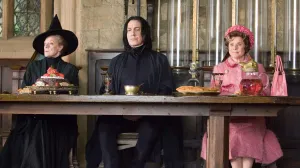
A new dream begins in The Dreaming: Waking Hours #1, from writer G. Willow Wilson, artist Nick Robles, and colorist Mat Lopes. Though the series fills the void in Black Label’s Sandman Universe line left by The Dreaming‘s finale earlier this year, it bears no connection to that story beyond the presence of The Sandman‘s primary character, Dream of the Endless. Wilson, Robles, and Lopes offer a fresh start for readers curious about The Sandman or its universe, and the team follows through on that opportunity with a well-crafted introduction broaching questions of identity, attribution, and intersectionality.
Videos by ComicBook.com
The Dreaming: Waking Hours centers its story on two leads. The issue first introduces single mother and graduate student Lindy. Then there’s Ruin, who is a nightmare released from captivity in the Dreaming who uses Lindy’s recurring dream to travel to the waking world. But Ruin, living up to his name, accidentally swaps places with Lindy instead of following her out, trapping Lindy in the Dreaming.
Lindy’s dissertation is a study of the many authorship theories about William Shakespeare, a longtime fixture of The Sandman‘s mythology. In explaining it to her adviser, Lindy says that the paper is “about how Shakespeare is perceived across time, and what the theories about his identity tell us about ourselves.” We get our first hint of what this means for Lindy, and for Waking Hours’ themes, in that conversation. Lindy is a woman of color with a newborn struggling to make ends meet while finishing her schooling. In her dream, she climbs the stairs of Shakespeare’s home, but never reaches her destination. Lindy is passionate about her work, but she’s beginning to feel that she’ll never break through the glass ceiling.
Lindy hopes that her adviser, an older white woman, will offer a sympathetic ear. Instead, the adviser is dismissive of Lindy’s project, choosing to list her past struggles instead of empathizing with Lindy’s current situation, suggesting that the student may want to reconsider her career path. It’s a critique of entrenched academic traditions and an indictment of the limits of traditional feminism.
Intersectionality and the roles of women and minorities are relevant again in Lindy’s later dream. The many authorship theories all coalesce, taking up space in Shakespeare’s home, but Wilson chooses to spotlight three. First, there’s Shakespeare’s wife, Anne Hathaway, whom some believe to be the real genius overshadowed by her husband’s name. Then there’s Sheik Zubayr, a Muslim on the run from the Inquisition. Lastly, there’s Kit Marlowe, who is a playwright believed to have been gay. Despite the house growing crowded, Hathaway tells Lindy that “we always find room for one more.” It raises questions about whether Shakespeare is the “great man”—great, white, heterosexual male—that history tells us he is or if something, or someone(s), was lost in the telling of his story.

For most of the issue, Robles’ artwork seems simple compared to that of the previous Dreaming series. He foregrounds expressive acting in his characters, a skill abundantly displayed here. But as the issue progresses, it becomes apparent that Robles is leaving room to intensify the visuals’ dreamlike attributes. When Ruin transforms from human-shape to nightmare form, snakes spilling out across the panel borders of the two-page spread, it underscores the unexpected wrongness of the moment. When Lindy finds herself trapped in a dream, the parchment shape of the layout emphasizes the strange new setting she’s in, and serve as the boundaries of her prison.
The preceding pages of the issue could serve with sharper visual distinctions between the waking world and the Dreaming, but much of that falls to Mat Lopes’ coloring work. Lopes casts our realities in relatively dull Earth tones compared to the searing violet accents of Lindy’s dreams. These colors follow her as she wakes in her bedroom, and they fall across her and her daughter’s face when they fall asleep, emphasizing these moments as the twilight border between her waking hours and dreaming.
Ruin’s portion of the story doesn’t get as much attention as Lindy’s. We learn that someone freed him from the Box of Nightmares and, after fleeing into the waking world, he takes Lindy’s child to see Jophiel, an angel cast out of heaven. We don’t get enough from Ruin to get a firm grasp on where his story is going, but there are hints. Simon Bowland follows in the footsteps of Todd Klein with his lettering choices for Ruin, giving the rogue nightmare a purple-pink balloon with white lettering. If bisexual lighting is a trend in film, this may be a case of bisexual lettering in comics, and it matches Ruin’s overall character design aesthetic nicely. Ruin is continuously put down, with Jophiel calling him a “most mediocre nightmare.” He seems to lack confidence in himself. Is it any wonder that Dream designed him to be a disaster by nature? Again, we get only hints at the direction of Ruin’s tale, but coming to terms with his identity looks to be a big part of it.
Therein is the biggest flaw with the issue. It is unclear how these two threads are tied together beyond Ruin using Lindy’s dream based on her home’s proximity to Jophiel’s earthly domicile. It makes Ruin’s part of the story seem vestigial. Future installments will flesh out Ruin’s history and likely solidify his place in the story, but the imbalance is noticeable in this issue.
The Dreaming: Waking Hours is a strong start for the latest iteration of The Sandman‘s sequels. Wilson deals with personal, relevant themes and takes advantage of the mythology of the Sandman Universe to do it in a way well suited to that world. Robles, Lopes, and Bowland are at the top of their game, with Robles seeming poised to break out at any moment. Intimate, intriguing, and lovingly crafted, The Dreaming: Waking Hours will lure in Sandman fans and newcomers alike.
Published by DC Comics
On August 3, 2020
Written by G. Willow Wilson
Art by Nick Robles
Colors by Mat Lopes
Letters by Simon Bowland
Cover by Nick Robles








